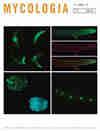系统发育分析表明,选择性制剂甘氨酸科尼西拉虫是一个具有显著形态和遗传变异的单一物种。
IF 2.6
2区 生物学
Q2 MYCOLOGY
引用次数: 0
摘要
大豆红叶斑病(RLB)是由真菌甘宁球孢霉菌(Coniothyrium glycines)引起的一种大豆叶面病害,迄今仅限于非洲。这种真菌被联邦选择制剂计划列为选择制剂,因为如果它在美国立足,会对植物健康造成严重威胁。以前的工作发现了内部转录间隔区的巨大分子多样性,这表明可能有多个物种会引起 RLB。为了确定是否有多个物种会引起 RLB,我们利用四个基因的序列数据重建了 C. glycines 和分类学盟友的系统发育。我们将从六个非洲国家收集到的 33 个 C. glycines 分离物纳入其中,并确定所有分离物都形成了一个支持良好的单系。在这一系中,至少有六个支持良好的支系,它们在很大程度上与地理位置相对应,其中一个支系完全由来自埃塞俄比亚的分离物组成,另一个支系完全由来自乌干达的分离物组成,还有四个支系由来自非洲南部的分离物组成。然而,我们没有发现这些支系的四个基因之间有任何一致性,这表明本分析中包含的所有分离物都是单一物种的代表。埃塞俄比亚支系中的分离株在形态上与其他支系中的分离株不同,因为它们在植物体内产生较大的菌核、较小的菌核和更多的菌核。此外,祖先分布区的估计表明,C. glycines 系出现在非洲南部。这些结果表明,这种高致病性真菌植物病原体的遗传和形态多样性远远超过了最初的猜测。本文章由计算机程序翻译,如有差异,请以英文原文为准。
Phylogenetic analyses show the Select Agent Coniothyrium glycines represents a single species that has significant morphological and genetic variation.
Soybean red leaf blotch (RLB), caused by the fungus Coniothyrium glycines, represents a foliar disease of soybean that is thus far restricted to Africa. The fungus is listed as a Select Agent by the Federal Select Agent Program because it could pose a severe threat to plant health were it to establish in the United States. Previous work uncovered tremendous molecular diversity at the internal transcribed spacer region, suggesting that there may be multiple species causing RLB. To determine whether multiple species cause RLB, we reconstructed the phylogeny of C. glycines and taxonomic allies using sequence data from four genes. We included 33 C. glycines isolates collected from six African countries and determined that all isolates form a well-supported, monophyletic lineage. Within this lineage there are at least six well-supported clades that largely correspond to geography, with one clade exclusively composed of isolates from Ethiopia, another exclusively composed of isolates from Uganda, and four composed of isolates from southern Africa. However, we did not detect any concordance for these clades between the four genes, indicating that all isolates included in this analysis are representative of a single species. Isolates in the Ethiopia clade are morphologically distinct from isolates in the other clades, as they produce larger sclerotia and smaller pycnida and more sclerotia in planta. Additionally, ancestral range estimations suggest that the C. glycines lineage emerged in southern Africa. These results show that there is significantly more genetic and morphological diversity than was initially suspected with this high-consequence fungal plant pathogen.
求助全文
通过发布文献求助,成功后即可免费获取论文全文。
去求助
来源期刊

Mycologia
生物-真菌学
CiteScore
6.20
自引率
3.60%
发文量
56
审稿时长
4-8 weeks
期刊介绍:
International in coverage, Mycologia presents recent advances in mycology, emphasizing all aspects of the biology of Fungi and fungus-like organisms, including Lichens, Oomycetes and Slime Molds. The Journal emphasizes subjects including applied biology, biochemistry, cell biology, development, ecology, evolution, genetics, genomics, molecular biology, morphology, new techniques, animal or plant pathology, phylogenetics, physiology, aspects of secondary metabolism, systematics, and ultrastructure. In addition to research articles, reviews and short notes, Mycologia also includes invited papers based on presentations from the Annual Conference of the Mycological Society of America, such as Karling Lectures or Presidential Addresses.
 求助内容:
求助内容: 应助结果提醒方式:
应助结果提醒方式:


